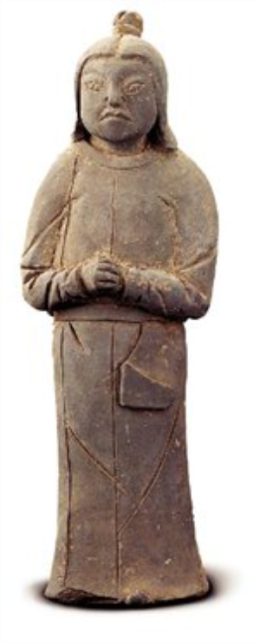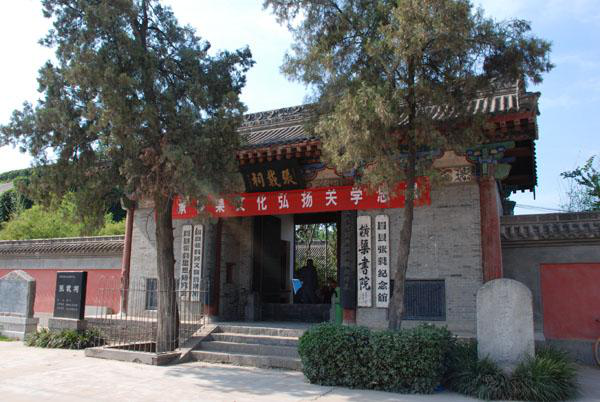The Practical Thinking of Guanxue
The Song Dynasty was not only an era of collecting the preceding culture but also an era of creating new cultures on the basis of its predecessors. The Neo-Confucianism, which had a profound impact on the China’s feudal society, was created in the Song Dynasty and became new theory of ideology based on the traditional ethical thoughts of Confucianism, and combined the theory of Confucianism, Taoism and Buddhism. If the Xi’an Forest of Stone Steles is a prominent symbol of the inherited culture of the Song Dynasty, the Guanxue, created by Zhang Zai, is the important representative of the innovative culture of the Song Dynasty.
Guanxue is an important school of Neo-Confucianism at the initiate stage. Its founder, Zhang Zai (1020~1077AD), was born in Chang’an. When he was young, he preferred books on the art of war. Later, he won the appreciation of Fan Zhongyan, abandoned weapons for literature under Fan’s persuasion, and embarked on the path of academic research. When studying the Confucian classics, he never stopped dabbling in a broad range of Buddhist theories. He had a foot in the door of official twice but was not successful. He spent most of his life in Hengqu Town, Meixian County, Shaanxi, concentrating on reading and writing, and finally created his own ideology, cultivated a large number of disciples, and formed a school with a strong lineup and far-reaching impact. Since his hometown was located in Guanzhong, and most of his disciples were from Guanzhong, the later generations named the school he created Guanxue (literally means Guanzhong School/Sect). Due to the reason that Zhang Zai was from Hengqu Town of Feng Xiang County (now Meixian County, Shaanxi), he was called Mr. Hengqu, and his school also had the name “School of Hengqu”.
As a separate ideology of Neo-Confucianism, Guanxue had distinctive characteristics. Guanxue advocated that practicability is of first priority, and learning is needed to meet practical needs. It tried to correlate academic ideas with political, economic, military and other issues in the real world to serve reality and opposed the superficial and impractical style of study. Guanxue focused on practical knowledge, and the real problems of society, which was quite distinct from the later Neo-Confucians, who only knew “how to salute and make some impractical comments on life”. In addition, Guanxue also paid special attention to ethics, emphasized the rites, and tried to correct the rites, which was popular but not in line with the ancient rituals.

The Song Dynasty maid figurines holding things
Guanxue of Zhang Zai, together with the Lianxue of his contemporaries, Zhou Dunyi, Luoxue of the brothers, Cheng Hao and Cheng Yi, and Minxue of Zhu Xi from the South Song Dynasty, were called the four schools of Neo-Confucianism, and Zhang Zai was regarded as one of the founders of Neo-Confucianism. Zhang Zai’s major academic achievements were in two aspects. He established the first philosophical system to systematically illustrate the world’s movement from the aspect of the qi and the yin yang in the Chinese history of philosophy. He proposed the distinctive ontocosmology of “Tai Xu Ji Qi” (all things of the world are composed of a primordial substance called qi) and “Yi Qi Wei Ben” (qi is the fundamental substance by which all processes of the universe can be explained) on the basis of concluding the current natural science and traditional Yixue. Furthermore, in the theory of human nature, Zhang Zai concluded and drew lessons from the ancient Chinese theory of human nature and created the dualism of human nature, “the nature of the heaven and the earth”, and “the nature of temperament”, which brought a satisfactory solution to the human nature which had been discussed since the Qin State for over a thousand years and had great divergent notions. After Zhang Zai’s death, the feudal rulers honored him and the Emperor Xiaozong of the Song Dynasty granted him the title of Mei Bo, and granted him “to be enshrined in the Confucius Temple”. During the Ming and Qing dynasties, Zhang Zai’s writings were considered to be representative of Neo-Confucianism, and the works must be read for imperial competitive examinations. His school and his philosophic thinking had significant impacts on the Chinese culture after the Song Dynasty.

Grey pottery warrior figurine
As the famous Neo-Confucian and leader of Guanxue, Zhang Zai left a valuable spiritual wealth for later generations. In addition to Commentary on the Changes, Correcting Ignorance, Quotations, Teachings of the Mystery and other works, his famous remarks “to revive the spiritual value for the society, to identify the meaning of life for the people, to inherit the old wisdom for the former sage, and to establish eternal peace for the future generations” were repeated and handed down generation by generation. Four remarks by Zhang Zai, also called Mr. Hengqu cover the ideas of spiritual values of the society and the people, the meaning of life, cultural heritage, political ideals and so on, which concluded the philosopher’s supreme realm and showed the grand vision of the scholars. These well-known sayings have an enduring popularity. In recent years, Premier Wen Jiabao quoted them many times while gave speeches overseas. In 2005, when Lien Chan the chairman of Taiwan’s KMT visited the mainland, he also quoted them while giving lectures to students in Beijing University. These examples show the strong inspirational force of these four famous sayings.

Temple of Zhang Zai in Meixian County
After Zhang Zai’s death, Hengqu Academy was established in his memory at the location where he studied in his youth. In the first year of Yuanzhen Period (1295AD), people began to construct the Temple of Zhang Zai on the site of the original Hengqu Academy. Recently, in addition to domestic tourists, it has also attracted many experts and scholars from France, Germany, Japan, Korea and the United States etc.to pay their respects to the sage at the Temple of Zhang Zai and to experience the wisdom of this philosopher.
When talking about the Guanxue, what fi rstly comes to people’s mind is Zhang Zai. In fact, in the history of Guanxue or even in the Chinese culture history, we have to mention some other people such as Lv Dalin from Lantian, Shaanxi, in the Song Dynasty. Lv Dalin, a famous Neo-Confucian and one of the earliest epigraphers in the country, is considered as the originator of Chinese archeology. Although he did not begin to engage in the collection and study of bronze ware until his later years, he was the earliest scholar to make a systematic research on bronze inscriptions. The two books Archaeological Picture and Archaeological Picture and Explanatory Notes written by him have laid the foundation for modern archeology and paleography. During his life, Lv Dalin wrote a lot of works, but most of the works related to Guanxue have been lost. Only the 10 volume Archaeological Picture were handed down, which demonstrate his infl uence and position in epigraphy. In 2008, the Shaanxi Provincial Archaeological Research Institute carried out excavation work on Lv’s family tombs located in Wulitou Village, Sanli Town, Lantian County, Shaanxi Province, and unearthed a large number of relics from the Western Zhou Dynasty to the Northern Song Dynasty which confi rmed the popularity of collecting and provided invaluable materials for the study of the history and culture of the Song Dynasty.
From the Song Dynasty to the Ming and Qing dynasties, several famous academies appeared, such as the Hengqu Academy in Meixian County, the Guanzhong Academy in Xi’an, the Hongdao Academy in Sanyuan, and the Weijing Academy and the Chongshi Academy in Jingyang. These academies had some similarities: firstly, they were mainly under the charge of famous scholars, such as Feng Congwu, Ma Li, Li Erqu, Liu Guyu and Bo Jingwei who were all famous Shaanxi scholars that held the position of presidents and lecturers in the academies. They regarded the promotion of academic culture and high moral character as their responsibilities, which enabled the academies to become famous all over the country, and the Guanzhong Academy could rank with the Donglin Academy in Wuxi City of Jiangsu Province and became another stronghold for the intellectuals to have a confrontation with the Eunuch Party. Secondly, these academies had a scientific and strict teaching and management system and fostered a large number of outstanding scholars for Shaanxi. Yu Youren, Li Yizhi, Chang Jiluan and etc. studied in these academies. Lastly, there were many hardships and frustrations in the process of their establishment, but the founders had overcome all the difficulties with amazing perseverance and dauntless courage, and this spiritual strength inspired and moved the majority of the learners and even the governors. After a journey of hardship, the impact of these academies was gradually expanded and they attracted students from Shaanxi as well as the neighboring Gansu, Henan, Hubei and Sichuan provinces and became renowned ancient academies in the northwest region and even in the whole country.

Excavation site of Lv’s family tombs in Lantian
The Ming and Qing dynasties were a prosperous time for famous scientists. Wang Zheng, with the title of “Xu Guangqi in the North Region”, was one of the famous scientists. Wang Zheng, born in Jingyang County, Shaanxi, was intelligent and studious from childhood. His book Illustration and Descriptions of Several Newly-built Devices recorded various agricultural tools and daily utensils he improved and invented, which were widely used later in production and daily life. Wang Zheng, who paid special attention on advanced western technologies, translated western works on technology in cooperation with western missionaries and wrote many important works and articles introducing western culture and technology to China, was one of the pioneers who had the whole world in view. One of his translations, A Record of the Best Illustrations and Descriptions of Extraordinary Devices of the Far West, was the earliest scientific work introducing western physics and mathematics in China. Many famous western missionaries were invited to Shaanxi by Wang Zheng; most of their own works and works done in cooperation with Wang Zheng were completed and published in Xi’an. Therefore, Wang Zheng is regarded as one of the technological initiators in modern China, the earliest figure who thought of rescuing the country with technology in ancient China.


